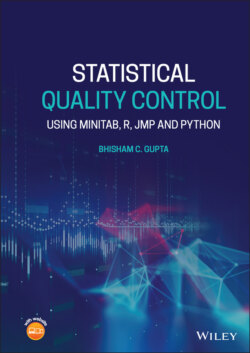Читать книгу Statistical Quality Control - Bhisham C. Gupta - Страница 49
2.3 Is Six Sigma New?
ОглавлениеThe origin of quality standards can be traced back to the medieval guild system in which craftsman placed their marks on only those products that met their standards. Quality tools such as statistical process control (SPC) charts date back to Walter Shewhart in 1924, and both W. Edwards Deming and Joseph M. Juran introduced quality thinking and methods in Japan after World War II. Japanese industry continued to innovate and develop quality systems and tools, with major contributions from Ishikawa, Shingo, and Taguchi, among others. In the last 70 years, there has been no shortage of quality programs touted as definitive solutions, including Total Quality Management, Quality Circles, and Zero Defects. Given the long history of quality, then, is Six Sigma new?
On the one hand, it can be argued that Six Sigma is simply a repackaging of existing quality know‐how. It is true that Six Sigma uses existing quality tools such as the Basic seven tools: cause and effect diagrams, check sheets, control charts, histograms, Pareto charts, scatter diagrams, and stratification; and the New seven tools: affinity diagrams, arrow diagrams, interrelationship diagrams, matrix diagrams, prioritization matrices, process decision program charts, and tree diagrams. (See Section 2.4.1.) Six Sigma’s focus on team problem‐solving is taken from Japanese practices such as quality circles. Both Deming and Juran advocated data‐based decision‐making and emphasized the vital role of management in successful quality implementation.
Several features of the Six Sigma approach are unique, however. Because Six Sigma requires data‐driven decisions, it has led to the widespread use of sophisticated statistical techniques. Analysis tools once only known to high‐level industrial statisticians, such as linear regression, chi‐squared tests, and designed experiments, are now routinely employed in Six Sigma projects by non‐statisticians. The project approach, in which upper management identifies project areas based on customer requirements and the overall business strategy, is unique to Six Sigma. In addition, the emphasis on reducing the variation in a process is a relatively new concept. Earlier quality efforts may have emphasized aligning processes to desired target levels but did not necessarily reduce the variation around those targets. Taguchi’s work in the 1980s introduced the importance of reducing variability to improve quality and reduce quality costs.
Finally, the requirement that quality improvement be tied directly to the organization’s bottom line is a distinct hallmark of Six Sigma. Six Sigma projects saved GE a reported $12 billion over five years (5). Results such as these have earned Six Sigma enduring popularity with executives.
